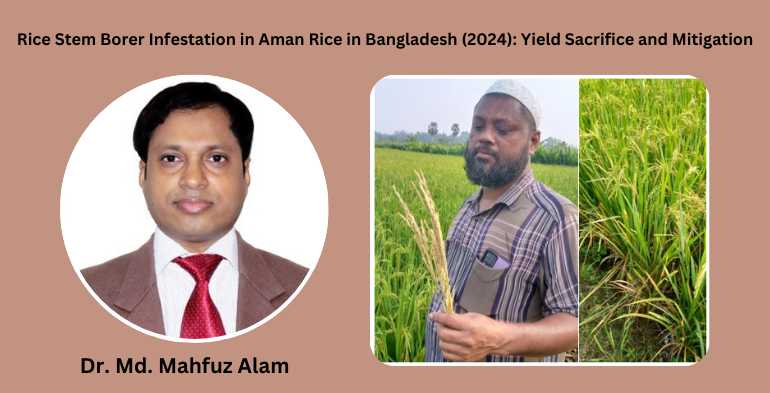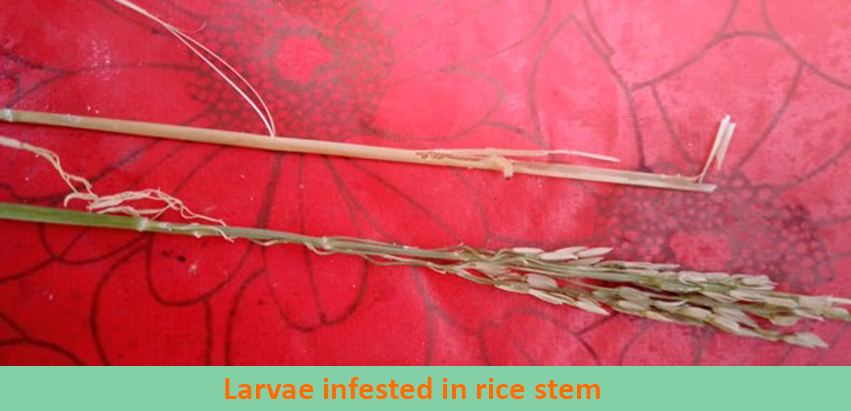
Dr. Md. Mahfuz Alam:Rice stem borer infestation is a significant challenge for Aman rice farmers in Bangladesh, causing damage to yields in 2024. During the Aman season in 2024, the country, particularly the regions of Sirajganj, Bogura, Rangpur, Mymensingh, Kishoreganj, Habiganj, Moulvibazar, and Sylhet, experienced a severe stem borer infestation. This led to a significant reduction in rice production, threatening food security. The primary pests responsible for this infestation are the rice yellow stem borer (Scirpophaga incertulas) and the dark headed stem borer (Chilo suppressalis). These pests attack the rice plants, leading to symptoms like "dead hearts" (the central portion of the rice plant turning brown and dying) and "white heads" (where the plant fails to develop proper panicles). The infestations can substantially reduce both the quantity and quality of the harvest. It poses a significant threat to rice yield, particularly during the crop's vegetative and reproductive stages. In severely infested fields, damage caused by rice stem borers can result in yield losses of up to 44%. Weather conditions play a crucial role in influencing stem borer populations and outbreaks can often be predicted based on specific climatic patterns.
Damage
Dead heart symptom:
The larvae of the rice stem borer penetrate the rice stem through the leaf sheath and feed on the inner tissues of the central shoot. This feeding damages the growing point, preventing the emergence of new leaves. As a result, the central shoot becomes brown, dry and resembles a "dead heart." The affected central shoot can be easily pulled out from the base of the plant. Discolouration often appears around the base of the affected leaves, which may also drop. Within the stem, tunnels created by the feeding larvae are visible. Dead heart symptoms typically manifest during the tillering to booting stages of the rice crop when the larvae target the growing point. Damaged tillers fail to produce panicles, leading to a direct loss of yield potential. In cases of severe infestation, the number of productive tillers is significantly reduced, resulting in considerable yield loss.

White Head Symptom: Stem borer larvae feed inside the rice stem, damaging the vascular tissues and disrupting the flow of water and nutrients to the panicle. This results in the panicle drying out. Affected panicles turn white, appear dried and fail to produce grains. Grains in the damaged panicles are either unfilled or completely absent. The affected panicles can often be easily pulled out. The larvae's feeding creates hollow tunnels within the stem. White head symptoms typically occur during the booting to heading stage of the rice crop, when the plant is forming or displaying panicles. Affected tillers fail to produce viable grains, leading to direct yield loss. Severe infestations can result in significant yield reductions, particularly when white heads are widespread across the field.
Yield Loss: Unproductive panicles significantly impact yield loss, especially during the critical reproductive phase. In severely infested fields, losses can range from 25% to 44%. In areas with high stem borer pressure, yield losses may exceed 50%, particularly in fields with poor management practices.
Impact of Weather
Weather conditions significantly influence the lifecycle and activity of stem borers, affecting their population dynamics and infestation rates. The adverse conditions during the Aman season in 2024 across the country have severely affected rice production. Key factors include:
Temperature: Stem borers thrive in temperatures ranging from 25°C to 30°C, a range that aligns closely with Bangladesh's typical climate.
Rainfall: Moderate to heavy rainfall during the growing season provides ideal conditions for stem borers. However, extremely heavy rains can decrease larval survival rates.
Humidity: High humidity levels (above 70%) encourage egg hatching and larval activity, increasing the risk of infestation.
Seasonal Variations:
Boro Rice: Infestation levels are generally lower during the dry season due to less favorable conditions during planting.
Aus Rice: Moderate to severe infestations can occur as this period often overlaps with the peak emergence of stem borers.
Aman Rice: Higher infestation rates are observed in the wet season due to favorable humidity and rainfall.

Life cycle
The life cycle of the rice stem borer consists of four distinct stages: egg, larva, pupa, and adult. The cycle begins when the female moth lays clusters of 200-500 eggs on the underside of rice leaves or leaf sheaths. These eggs hatch in 5-8 days under favourable environmental conditions, such as warm temperatures (25-30°C) and high humidity. The larvae that emerge from the eggs are the most destructive stage of the pest. They immediately burrow into the rice plant’s stem, where they feed on the internal tissues, causing the plant to develop characteristic symptoms like deadheart (where the central shoot wilts) and whitehead (where the panicle dies off, preventing grain formation). This larval stage lasts around 25-35 days, during which the larvae grow and molt several times. As the larvae mature, they bore deeper into the rice stems, further weakening the plant. Once fully developed, the larvae exit the stem to pupate. During the pupal stage, which lasts 7-10 days, the larvae form a cocoon in the rice plant’s stem or leaf sheath and undergo metamorphosis into adult moths. The adult moths, which are nocturnal, are light brown or yellowish in color and have dark markings. After emerging from the pupal case, they mate and lay eggs on young rice plants, starting the cycle over again. The adult stage typically lasts 4-10 days. Temperature, humidity and rainfall significantly impact the development and survival of each stage, with high humidity and temperatures in the ideal range accelerating the life cycle and increasing the risk of infestation which make easier for stem borer in Aman rice in 2024.

Integrated Pest Management (IPM)
- Field Monitoring:
- Regularly inspect fields for the presence of moths, egg masses, and early signs of dead heart.
- Inspect fields regularly for signs of whitehead during the reproductive stage.
- Use light traps to monitor adult stem borer populations.
- Preventive Measures:
- Resistant Varieties: Use stem borer resistant rice varieties developed by agricultural research institutes.
- Early planting: Adjust planting time to avoid peak pest activity.
- Destruction of stubbles: Plow under or burn rice stubbles after harvest to eliminate overwintering larvae.
- Water management: Flood fields intermittently to kill larvae inside the stem.
- Cultural Control:
- Practice synchronized planting within an area to disrupt pest cycles.
- Use of balanced fertilization (avoiding excessive nitrogen) to reduce pest attractiveness.
- Remove and destroy affected tillers, reduces the pest population in the field.
- Trap crops: Plant small patches of early maturing rice to attract stem borers, which can then be destroyed.
- Biological Control:
- Introduce Trichogramma parasitoids to control stem borer eggs.
- Promote natural predators such as spiders, ladybirds, and predatory wasps.
- Chemical Control:
- Apply insecticides like Chlorantraniliprole (sprayed during critical stages) during the early larval stage when eggs have hatched but before larvae burrow into the stem.
- Use systemic insecticides (Cartap 92%, Acetamiprid 3% (95 SP)/Tetraniliprole, fipronil/Flubendiamide) for better efficacy as they can reach the feeding sites of the larvae.
- Weather-Based Monitoring:
- Predict stem borer outbreaks using weather data (e.g., temperature, humidity, and rainfall) to time interventions.
Conclusion
Managing rice stem borer in Bangladesh requires a coordinated approach involving farmers, agricultural extension services and government agencies. By combining weather-based monitoring, cultural practices, biological control and judicious use of pesticides, the impacts of this pest can be minimized, ensuring sustainable rice production.
Written by:Dr. Md. Mahfuz Alam
Ph.D (Ehime University, Japan)
Principal Scientific Officer
Crops Division, BARC, Bangladesh























